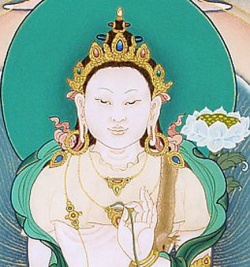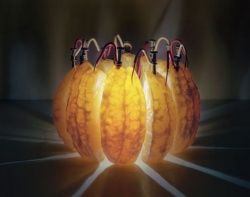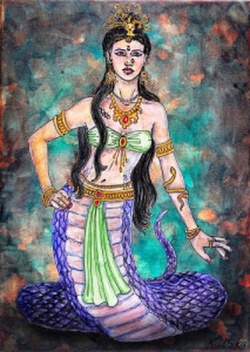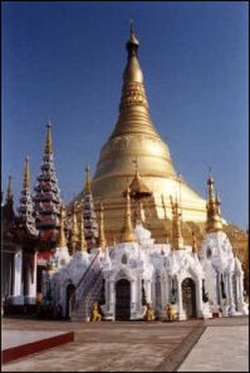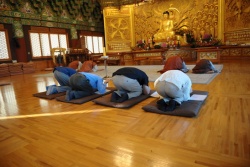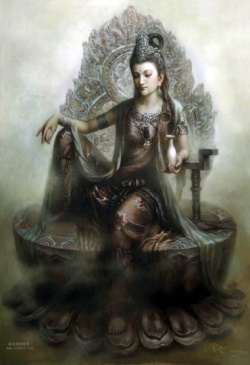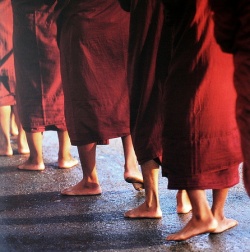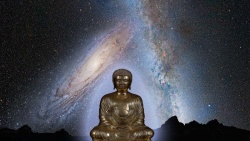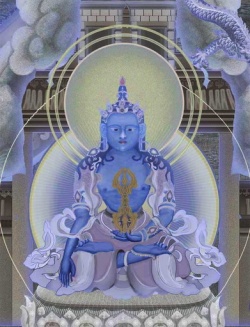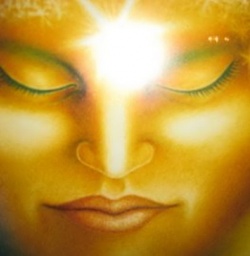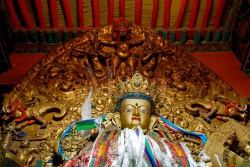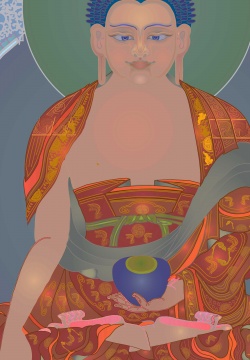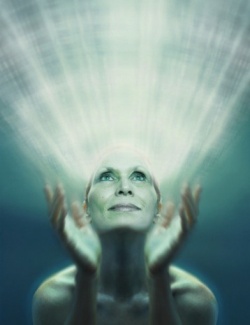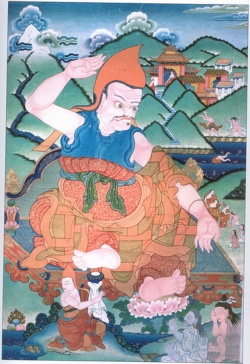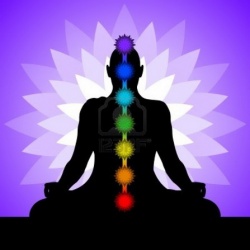Three Nons and Two Kinds of Samadhi
The Essence of the Sixth Patriarch's Teachings
Master Hui Neng, the Sixth Patriarch of the Ch'an School, lived and taught in the Bao Lin Monastery (presently called as Nan Hua Temple) in Guangdong Province for forty years, spreading Buddhist teachings to countless sentient beings. He preached exhaustively the orthodox and essential teachings of the Ch’an practice. Later, his five disciples formed the five major branches of the Ch’an school. The essence of his teachings can be summed up as Three Nons and Two Kinds of
Samadhi. Three Nons refer to the three states internally realized by practitioners that can be described respectively as Non-thought (thoughtless) as the Object, Non-form as the Entity, and Non-attachment as the Basis. The Two Kinds of Samadhi are Samadhi of Oneness and Samadhi of One Form. Each of these teachings will be expounded in this paper.
I. Non-thought as the Object.
Non-thought refers to the Thought Arising from One’s True Nature. It is the attribute of Suchness that gives rise to ideas, which can function as the Miraculous Usage of “Practicing the Path Without Making Efforts in Cultivation” (the author’s note: After one’s consciousness is subdued, his true nature surfaces. Naturally, whatever he does is an act of cultivation. Thus, he does not need to make special efforts.) Object here means that the practitioner can obtain Buddhas’ Energies of the ten directions, penetrate sentient beings’ minds and bless them by transferring the Buddhas’ Energies to them through his own
mind. When one reaches this state in his practice of Ch’an, he has attained the highest stage and is completely enlightened. He is then qualified to carry on the Wisdom Life of the Buddha and transmit the Buddha’s Mind Seal. Of the thirty-three generations of patriarchs in the Ch’an lineage, from the first Patriarch Mahakasyapa to Master
Hui Neng, there was only one such patriarch in each generation. This fact shows that enlightened masters with such capacities are rare and difficult to encounter. Shen Xiu was an well-educated instructor who enjoyed high reputation among the Fifth Patriarch’s disciples. However, Master Hong Ren would rather pass the Robe and Dharma to Hui Neng, for Shen Xiu was not enlightened
and therefore not able to transmit the Buddha’s Mind Seal. On the other hand, the Fifth Patriarch knew that even though Hui Neng was illiterate, he had been enlightened, attained the internal realizations of the “Five Would Have Thought”1, and could transmit the Buddha’s Mind Seal. He could also give people appropriate and enlightening Dharma talks.
The Sixth Patriarch said: “Non-thought means that when involved in thought, the practitioner is not attached to it”2 The Dharma theory is as follows. A practitioner can truly realize the state known as Non-thought as the Object only after he has eradicated the Discriminating Attachment to Ego, the Discriminating Attachment to Things as Reality, the Innate
Attachment to Ego and the Innate Attachment to Things as Reality. At this stage, the Sixth Patriarch’s teaching “It is the attribute of Suchness that gives rise to idea”3 refers to the Thought of Egolessness. Such thoughts are different from mundane people’s delusions. Therefore, the Sixth Patriarch continued to say: “Non-thought means that when involved in thought, the practitioner is not attached to it”. People must distinguish the word Thought used in this particular
phrase from mundane people’s thought that is controlled by their consciousness. Thought in the former case means Realization of the Self-nature or what the Sixth Patriarch instructed as “Suchness is the substance of thoughts and thoughts are the function of Suchness.”4 The Sixth Patriarch went on to say: “Suchness is the substance of thoughts;
thoughts are the function of Suchness. If you give rise to thoughts from your self-nature, then, although you see, hear, perceive, and know, you are not stained by the manifold environments, and are always free. The Sutra says: “Externally, while distinguishing well all the forms of the various Dharmas, internally he stands firm within the First Principle.’”5 Ordinary people’s
thoughts are controlled by consciousness and veiled by ignorance. Whether they are free from thoughts or not, they are under delusions by day and night. In order to prevent the audience from misunderstanding and misusing the purport of “Non-thought as the Object”, the Sixth Patriarch gave another instruction. It quotes: “If you stop thinking of the myriad things, and cast aside all
thoughts, as soon as one instant of thought is cut off, you will be reborn in another realm. If you do so, it will be bad enough that you yourself are in error, yet how much worse that you encourage others in their mistakes. The man, however, does not himself see and slanders the teachings of the sutras.”6
Two examples are cited hereafter to illustrate this point.
1. Shakyamuni Buddha picked one golden flower and Mahakasyapa smiled in apprehension. He became the First Fully-enlightened Patriarch of the Ch’an School. The whole entity of Suchness contains various Natures, and each nature contains attributes of one another. It can function independently or merge with another as a whole in unity. Each Seed Nature is interconnected with one another. The Song of Enlightenment quotes: “The One Nature perfectly pervades all others. The one Dharma enfolds all other Dharmas. The One Moon is reflected by all waters. All the moons reflected in the water are converged by one moon. The Dharma-Body of all Buddhas pervades my nature; I am united with the Tathagatas.”7 A practitioner who has attained this state can penetrate the wonderful purport of the Sixth Patriarch’s words that it is the nature of Suchness that gives rise to thoughts. At this stage, he can transmit the Buddha’s Mind Seal. The Sixth Patriarch’s verse “Who would have thought that the self-nature is intrinsically self-sufficient!” shows that Suchness includes all Seed Natures. His another verse “Who would have thought that all Dharmas are the manifestations of the self-nature” means that the Wonderful Existence can derive from the True Void. Shakyamuni Buddha entered the highest stage of Samadhi in the Ch’an practice, manifested to them the Wonderful Purport of the Arising of Wonderful Existence from True Void, and blessed the assembly. He picked one flower to show them the highest Ch’an practice, which is the Arising of Wonderful Existence from the True Void. It is as pure and unpolluted as lotus blossoms. The one million humans and Devas present in the assembly didn’t understand the Buddha’s message except Mahakasyapa who smiled in apprehension. The Buddha said: “I have the Storage of Real Dharma Eye, the Wonderful Mind of Nirvana and the profound Dharma-door that Reality is Formless and I’ll transmit these to Mahakasyapa.” The Buddha then announced to the public that Mahakasyapa had attained the Wonderful Purport and could teach them from then on.8
The purport of Oneyana (One Vehicle or Buddha Vehicle) is also called the Storage of Real Dharma Eye. One cannot appreciate the mystic transmission of Buddha’s Mind Seal unless he has attained the real Dharma Eye. It is also called the Wonderful Mind of Nirvana as this mind in tranquility has the great potentials for permeating into things ceaselessly. (The author’s note: Refer to An Elaborate Explanation of the Heart Sutra by Maha Acarya Feng Da An for detail).
2. Lu’s misunderstanding of the Non-discriminating Wisdom…(omitted).
Verses Delineating the Eight Kinds of Consciousness quotes: “The transform of the perceived division in the contemplation of emptiness is merely Later Attained Wisdom.”9
II. Non-form as the Entity
When enlightened people enter deep Samadhi, they can penetrate the pure nature of all phenomena that is devoid of any form. This is the state described by the Sixth Patriarch as Non-form as the Entity. The Diamond Sutra quotes: “If a person can subdue all phenomena and enter the wonderful state of Suchness, in which he experiences neither substantial entity nor void, and he has no idea of subduing, it is called Anuttara Samayaksambodhi.” This is the internal realization when one has realized the state Non-form as the Entity.
The Sixth Patriarch said: “Non-form is to be separated from form even when associated with form.”10 The Dharma theory can be explained hereafter. The various phenomena like material appearance and mind come into being if there is reception. They will interact with one another. However, deep-rooted habits form Skandha, among which thinking is the major part. The beginning of activities of various phenomena is only the flow of Wonderful Nature, with no form to indicate. When thinking has arisen, they are transformed into forms. Therefore, it is thinking that makes the various phenomena like material appearance and mind manifest themselves in forms. If thinking does not exist, all phenomena will be devoid of forms. This is the essential purport of the Sixth Patriarch’s teaching. Consciousness arises when one’s sense objects interact with the external environment. Consciousness opposes forms. When both the internal and external consciousness are subdued, all the phenomena will vanish without leaving a trace, and the practitioner will have nothing to obtain. The myriad phenomena of this mundane world are all illusive mirages formed by sentient beings’ attachment to consciousness and delusions arising from obscuration of their self-nature. If a practitioner can reach the stage where he can transform his consciousness into wisdom at will, he can penetrate the true nature of all phenomena, which is devoid of any form. This is the fundamental principle for the state Non-form as the Entity.
The Sixth Patriarch said: “In expounding the Dharma, I speak from my self nature. To do it otherwise would indicate that the expositor touches the phenomenal side of the Dharma only and his self-nature is under obscuration.”11 Shakyamuni Buddha’s Dharma talks all flew from his true nature. When Buddhas kindly protect and bless Bodhisattvas, their Energies are great. When they teach Bodhisattvas, their teachings are appropriate and in accordance with the Buddhist truth. If practitioners with good roots bear such instructions in mind and apply them to actual practice, when conditions are ripe, they can become enlightened instanteously. However, when ordinary Dharma masters give talks or when people with ordinary spiritual capacity listen to such talks, there would not be such effects. This explains why the Fifth Patriarch would rather pass his Robe and Dharma to Hui Neng than to Shen Xiu.
Penetrating the True Nature actually means that the practitioner has internally realized the state of Bodhi. Practitioners of both the Ch’an School and Esoteric School often practice the Moon Disc Contemplation to attain Bodhi. The Mahavairocana Sutra quotes: “What’s Bodhi? It is the realization of one’s True Nature. When I contemplate on my mind, it is like a moon disc.” Bodhidharma instructed Master Hui Ke In this way, saying: “Wonderful and round is the pure wisdom, the nature of which is emptiness and tranquility. Such merits and virtues cannot be obtained in this mundane world.” The Song of Enlightenment says: “Only get the root. Have no concern for branch tips. It’s like a precious moon hanging in the space permeated with infinite crystal lights. Now that I have obtained this wish-fulfilling Pearl, both myself and others will benefit inexhaustibly.”12 Ch’an Master Han Shan’s poem reads: “My heart is like a moon in the autumn., brightly shinning upon crystal-clear pond. Nothing is comparable. How can I describe it in words?”13 A practitioner starts the Moon Disc Contemplation with the practice of mind concentration. Actually, there is no such real object as a beautiful moon of the universe in front of him. After he has achieved such contemplation regularly, the moon disc will not surface. All he can feel is complete tranquility and brightness permeating through the whole Dharmadhatu. In Samadhi, he experiences that there are no physical body, no mind, and no phenomena. Even there is no idea of transcendence of them. As all vexations have vanished, there is nothing to deal with. He has attained the Wisdom of the Embodied Nature of Dharmadhatu (Dharmadhatu-prakriti-jnana). (The author’s note: Refer to the Handbook for Esoteric Practitioners by Maha Acarya Feng Da An for detail.) Once the practitioner has reached this state, he not only penetrates the true nature of all phenomena but also can use it appropriately.
All electric appliances have to be connected with electric current to work properly or they are like waste products. Likewise, no matter what Dharma-door (method or door leading to enlightenment) a practitioner chooses, he must correspond to the Buddhas’ Energies to attain a higher stage quickly. Therefore, whether one can practice with a fully enlightened master who penetrates the true nature of all phenomena can decide if he can have Right View and achieve quick effect in practice. Without the blessings and instructions of an authentic Guru, the practitioner can hardly correspond to Buddhas’ Energies, just like an electric appliance that cannot function if not connected with electric current. He could even become insane if he practices with a heterodox master. A practitioner must be very careful in choosing his Guru and the Dharma-door.
The Gong An (Koan or case) described in the Platform Sutra about Chen Hui Ming’s seeking Dharma from Hui Neng can well illustrate this point.
III. Non-attachment as the Basis.
The first two Nons describe the states a practitioner has attained. In order to reach these two states, the practitioner must follow the Sixth Patriarch’s teaching “Non-attachment as the Basis”. The Sixth Patriarch said: “If we free our minds from attachment to all things, the Path would be clear; otherwise, we would have ourselves under restraint. If we allow our thoughts, the past, the present and the future ones, to link up in a series, we would put ourselves under restraint. On the other hand, if we let our minds attach to nothing at all times and towards all things, we gain emancipation. For this reason, we take Non-attachment as our basis”. 14An Elaborate Explanation of the Heart Sutra quotes: “If the mind clings to things, it is self-bound. As the nature of all things is emptiness, they can manifest themselves on an equal basis. If one’s mind stagnates in thinking of one thing and he cannot subdue this thinking, it will become an obstruction for other phenomena to manifest themselves. This is what a Chinese proverb describes as “Attending to one thing and losing sight of another.” As thinking has already become an obstacle, it gets into Sanjna (perception). If one intends to restore the Equality Dharma Nature, he must try hard to do away with Sanjna. ”15
One must do away with his Sanjna in order to restore the Equality Dharma Nature. To achieve this purpose, he should start from practicing Non-attachment.
As people are attached to worldly passions, ignorance arises, which in turn makes them commit crimes or suicides. The tragedies to be mentioned hereafter wouldn’t have taken place if the victims had dealt with the problems with their minds free from any attachment.
1. July this year, a female student from a financial college killed herself by jumping from a building because the man she fell in love with refused her.
2. July this year, a female student from a teachers’ university was killed by her former boyfriend for her triangle love affair.
3. Several years ago, a movie star in Hong Kong called Lin Dai killed herself because of some small matters.
4. Several years ago, a man beat a woman to death in Hui Zhou City simply because the woman was pouring water to the street and the water happened to wet the man’s clothes.
5. During the so-called Cultural Revolution, many people committed suicide because they could not tolerate the humiliation or injustice done to them.
6. Two students from a medical institute went crazy after they practiced Qi Gong. One died and the other was seriously injured.
As mundane people do not believe Buddhism and the Buddhist doctrines of the law of cause and effect, of Karma and reincarnation, they hold the view of annihilation. Thus, they preach that one should better seek worldly pleasures as one’s youthful days do not last long. They do not understand the value of life, so they spend all time and energy satiating mundane desires, and they are especially attached to love.
In the first example given above, the girl student felt that her life was meaningless because the one she loved rejected her. She thought that she could put everything to an end by committing suicide. As a matter of fact, her death was not the end of her life. She would suffer more miseries after she died, and her death brought disgrace not only to herself but also to her family members. Many worldly people do not have moral standards for love, so they play fast and loose. As a result, families become disharmonious and finally split. The members are vexed. Sometimes, tragedies can even take place.
In the second example, the man cannot escape capital punishment for killing his ex-girlfriend. The girl student should also bear some responsibility.
Both the third and fourth examples are contingent cases. If these people had learnt the Buddhist teaching “When evil ideas arise, one should not take any actions when he is aware of them”, they would have broken off ignorance and thus not committed such evils.
The fifth example is a case of catastrophe caused by Mutual Karma. When people are humiliated or done injustice to, their reactions are very important., as different mentality will lead them to make different choices. At a critical moment, one’s life and death is decided by a momentary slip in thinking. During the Cultural Revolution, some intellectuals, when insulted by the Red Guards, still clung to the conventional idea that a scholar would rather die than be humiliated. Their attitude and reactions brought them even harsher torture from the Red Guards. As some could not tolerate such humiliation, they even committed suicide However, Buddhists would think that the sufferings they are undergoing now are triggered by their evil-doings in previous lives and they should not abide in such sufferings. The Diamond Sutra quotes: “If a good man or good woman who accepts, upholds, reads or recites this sutra is despised, that is because that person has Karmic offenses from past lives which destine him for the evil paths. But as a result of the despise they received from others in his present life, his previous Karmic offense are destroyed…” It is good for one to be punished less severely for his heavy Karmic offenses. If a man could think in this way, he would surely be able to detach himself from the suffering and thus tide over difficult periods in his life. There used to be a monk who supported himself by cooking grass to dye cloth. Due to his previous evil Karmic deeds, a pile of ox bones appeared in his workplace. The man who lost his cattle traced the bones to the workplace, so he accused the monk of stealing and killing his ox. The monk was thus sentenced to jail. He was wrongly charged, however, he chose to stay in prison instead of making any complaints or plea. He knew that he was once a butcher of oxes in his past life. For the act of killing, he should be reincarnated in the evil paths. His imprisonment was actually a light retribution for his heavy Karma. Therefore, he spent the time in prison with peace of mind. He had the supernatural power to appear at will in any place, to fly or go without hindrance, yet he wouldn’t escape as he was well aware that supernatural powers could not resist the Karmic forces. If he escaped, the retribution would be even more serious, and he would be punished sooner or later. With a mind free from attachment to the suffering, he tided over the difficult period.
People with ulterior motives and those without clear aims to practice Qi Gong can sometimes go insane. Two students saw illusions in their practice. Their minds became so attached to the phantoms that they went crazy. One climbed up the Pagoda of the Six Banyan Trees in Guangzhou to practice Qi Gong. With the intention of hovering with the illusive devil, he jumped from the pagoda and was seriously injured. Another student went to the top floor of a building, jumped into the air, and crashed to the ground. These two students would not have become victims if they had read the verse from the Diamond Sutra. It quotes: “Someone who looks for me in form or seeks me in sound is on a mistaken path and cannot see the Tathagata.” If both of them ignored the phantoms that appeared in their practice, such tragedies would not have taken place.
It is hard for a person to free his mind from attachment to worldly passions. Some bitter and painful experiences will automatically surface even though he does not want to abide in them. The famous Chinese poet of the Song Dynasty Su Dong Po once wrote a poem in memory of his deceased wife Wang Zhao Yun. Some verses read: “To my mind have constantly come thoughts of you: Things I cannot forget, loving you as I do…Face to face, we were dumb; or so it seems. Not a word, but tears flowing down in streams…”16 As the bitter seeds of recollecting his love were deeply rooted in his heart, he could hardly restrain himself from sorrow. In order to subdue such sentimental state of mind and thus achieve complete non-attachment, one must harbor the wish to be liberated from the bitter sea of suffering. At the same time, he must also get the compassionate protection and blessings of Buddhas and Bodhisattvas.
One of my disciples Miss Luo Xiao Duan is a good example. By reciting the Cundi Mantra, she changed from a short-tempered girl into an amiable and kind girl.
The Diamond Sutra quotes: “Due to the Asamskrta Dharmas which are not subject to causes, all sages and saints differ.” This sentence actually means that their internal realizations differ with the level at which they have severed attachment, i.e., Srotta-panna, Sakridagamin, Anagamin, Arhant, Pratyeka Buddha, Bodhisattvas of ten stages and Buddhas. These are the stages of cultivation for Exoteric practitioners. For Ch’an practitioners, there are three stages (passes).
When Maha Acarya Feng Da An was in the causal stage of practice to reach Buddhahood in this single lifetime, he had reached the highest stage of Ch’an School before he attained the highest state of esoteric practice. His stanza entitled “Passes for Ch’an Practice” reads as follows:
“Not attached to the Six Dusts, the heart started to get pure. With the seven kinds of consciousness subdued, the state of non-birth was achieved.
After the ten directions of worlds were penetrated and self-nature realized, Happily, I am now delivering sentient beings in this mundane world.”
This stanza corresponds to the esoteric meaning of the Gate Mantra from the Heart Sutra. Someone asked me: “The Sixth Patriarch said ‘If we free our minds from attachment to all things, the Path would circulate.’17 I'm a happy-go-lucky man. I never worry about anything. If the sky fell down, I would take it as a comfortable quilt to cover my body. I believe in fate and the popular saying that one can only get whatever is destined for him. I never compete with others for promotion and raise of salary. I also believe that both good and bad deeds will be repaid. I would rather be betrayed than betray others. I never attach myself to injustice that others have done to me. Would such attitudes correspond to the Sixth Patriarch’s words that one should free one’s mind from attachment? If this is true, why cannot I attain the internal realization as implied in his words?”
My reply is as follows: “Gentle, upright, broad-minded, forgiving, carefree and generous person who likes to cultivate goodness naturally has good roots. However, before he is enlightened, the Vexation Obstruction and the Obstruction of the Known still exist, and the Attachment to Ego and the Attachment to Dharma have not been eradicated, so he cannot reach the state of complete non-attachment. His quick and bright True Nature is still veiled by ignorance, and he has not attained to this stage. However, such people can make rapid progress in spiritual cultivation if they get the empowerment of the Three Secrets.
It is the seven kinds of consciousness that make sentient beings create Karmic deeds, reincarnate in the paths of existence determined by their Karmic deeds, and transmigrate ceaselessly in the bitter sea of life and death. The Dharma theory can be explained hereafter. The Innate Attachment to Ego originates from the Seventh Consciousness. Within the heart, sentient beings hold the concept of ego and existence. They also differentiate this physical form from that physical form. Whether they are awake or asleep, there is not one moment they do not attach to such delusions. Day and night, they are attached to the false concepts. Therefore, they treat people who bring them benefits as friends and those who bring them harm as enemies. This is the source of troubles in this world. One must subdue the seven kinds of consciousness in order to reach the state of Non-attachment. Otherwise, the Vexation Obstruction and the Obstruction of the Known would still exist, he can hardly detach himself from worldly passions, and so it is even more difficult for him to attain any internal realizations. When Bodhidharma came to China from the West, he saw that many Chinese practiced Buddhism by studying scriptures and they were contented with the understanding of the literal meaning of those texts. This became the barrier to the realization of one’s true nature. Therefore, he encouraged practitioners of the Oneyana Sudden School to devote their cultivation to actual practice, which can further their comprehension of the Buddhist teachings. He advocated that the teachings of Oneyana are directly pointing to the heart leading to one’s enlightenment. If a practitioner with good roots seeks the Dharma with utmost sincerity, gets the empowerment from a fully enlightened master, and corresponds to the blessings of the master, when conditions are ripe, his heart will open and the internal light will illuminate. He has reached the first stage of the Ch’an practice. If in Samadhi, he no longer feels the existence of both his physical body and the Gen Shen, he has reached the second stage. When his true nature and all phenomena are merged into Oneness and he can make them function at ease, he reaches the highest stage of Ch’an practice. At this stage, all this vexations are transformed into Bodhi, and he reaches the internal state of Nirvana. He has attained the Dharmakaya.
The Diamond Sutra quotes: “That is why we should not get caught in Dharmas or in the idea that Dharmas do not exist. This is the hidden meaning when the Tathagata says Bhikkhus, you should know that all of the teachings I give to you are a raft. All teachings must be abandoned, not to mention non-teachings.” This is the Wonderful Purport of complete non-attachment. There was a man called Wang Shi Zi from Shao Zhou. He looked like a dignified and sedate Indian monk with incomparable integrity. He started Buddhism practice from scriptural study and indulged himself in understanding of the literal meaning of those sutras. As a result, he became arrogant and enjoyed defeating other people in discussion of Buddhism. Later on, he went to seek instruction from Ch’an Master Zu Xin. Immediately upon his arrival, he started his eloquent speech. The master scolded him, saying: “You have been talking about food. Can such empty talk about eating make your stomach full?” Wang Shi Zi became embarrassed at once and his face turned red, as he knew that he did not have any internal realizations. Feeling both guilty and remorseful, he beseeched the master to show him the Tranquil and Blissful Place. The master replied: “The Tranquil and Blissful Place prohibits your Old Stuff.” (the author’s note: Old Stuff here refers to the understanding got through pondering hard on the literal meaning of Buddhist scriptures. Such understanding is unreliable and would turn into the Obstruction of the Known. That explains why the Fifth Patriarch told his disciples that pondering was useless.) You must subdue all your thinking before you reach the Tranquil and Blissful Place.” (The author’s comment: This means that a practitioner can attain the state of Non-attachment only after he has broken off all kinds of attachment.) Wang Shi Zi accepted this instruction and stayed to practice with master. With persistent endeavor, hard practice, the instruction and blessings of the master, he realized the True Nature. Later, he became a patriarch and was called Ch’an Master Wu (enlightened) Xin (new).
I began to practice Buddhism from studying Buddhist scriptures when I was a middle school student. As I was contented with the understanding of the literal meaning of Buddhist texts, I became conceited and enjoyed showing off my knowledge. Luckily, I had the chance to meet Maha Acarya Feng Da An who gave me valuable instructions. He even wrote a poem advising me to guard against this obstacle to spiritual cultivation. The stanza reads:
“Indulgence in the study and comprehension of the literal meaning of Buddhist sutras, Will transform into an obstruction to one’s realization of Prajna If everything is dealt with the sparkle of true wisdom You have attained the Prajna”
He also asked an outstanding disciple Wu Pu Cong to talk with me about the importance of actual practice. They made me realize that my previous cultivation was wrong. From then on, I devoted most of my time and energy to actual practice, and the wisdom derived from real cultivation helped me understand the true meaning of Buddhist sutras. This was an important experience and was also a major change for me in the path of Buddhism practice.
Intellectuals mainly begin their practice by studying Buddhist doctrines. This is not bad in itself, but they should not be contented with understanding of Buddhist teachings through pondering on their literal meanings. They should fully realize that the sutras could only function as the fingers pointing to the moon. The Diamond Sutra quotes: “The so-called Buddhist Dharma is not Buddhist Dharma.” If they mistake the fingers as the moon itself, it is the Non-dharma as described in the sutra. The Sixth Patriarch said: “When our minds are under delusion, the Lotus Sutra is beyond our comprehension. With an enlightened mind, we penetrate the true meaning of the Sutra instead.” “The profundity of various Buddhas’ teachings has nothing to do with written words.” “Self –nature is intrinsically self-sufficient. All the Dharmas are the manifestation of the self-nature.” “Bodhi is to be found within our own mind. And there is no necessity to seek for mysticism from outside.”
Someone asked: “The Diamond Sutra quotes: ‘Your mind should thus abide and be subjugated in this way.’ Amitabha Buddha and Mahasthama instructed the determinant factors for one to be reborn in the West Pure Land as follows: 1. Once cannot be reborn in the Land of Ultimate Bliss with few good roots, blessings, virtues, and conditions. 2. He must be single-minded and remain in the state of continuous Pure Thoughts. Do these words contradict with Sixth patriarch’s teaching that ‘If successive thoughts—the prior thoughts, present thoughts, and future thoughts follow one after another without cessation, his is known as being fettered.’18 Further, do the two verses ‘the mind should thus abide’ and ‘remain in the state of continuous Pure thoughts’ contradict with the Sixth Patriarch’s teaching that Non-attachment is the Basis?”
The reply is as follows: Asvaghosa Bodhisattva said: “When Suchness penetrates ignorance, sentient beings can eliminate their Karmic obstructions and reach enlightenment. As their previous delusions disappear and the true nature surfaces, they reach a state of complete tranquillity and brightness; their minds become purer and quicker. On the other hand, when ignorance defiles Suchness, their true nature will be veiled by delusions, their negative karmic actions will accumulate, and they will be bound by the cycle of life and death with endless mental afflictions.”19 What is quoted from the Diamond Sutra and the instructions given by Amitabhaa Buddha and Mahasthama Bodhisattva refer to the Wonderful Function of the Permeation of Suchness into Ignorance. With such penetration of Suchness into ignorance to subjugate the practitioner’s mind, he can then use his mind with non-attachment. What the Sixth Patriarch taught refer to this state. He warned practitioners against attaching themselves to phenomena and letting ignorance permeate into their Suchness. In this way they would not be fettered by vexations. Therefore, the sayings quoted above do not contradict with each other.
Another man asked: “The Diamond Sutra quotes ‘If a Bodhisattva’s mind does not abide in forms when practicing giving, his merit will be inconceivable and immeasurable.. All phenomena are illusive. If one sees all the forms as non-forms, one sees the Tathagata.’ The Song of Enlightenment also reads: “When reality is attained, there is neither ego nor object; and within that instant, the Karma of eternal suffering is wiped away. If this is a lie to deceive living beings, for ages as numberless as dust, let my tongue be plucked out.’20 What is the relationship of the above-mentioned verses with Non-attachment?”
I would like to explain to people who have such questions in person.
Someone else asked: “The Dharma transmission stanza of the Lin Ji Sect quotes:
Asking how to end the river of reincarnation running ceaselessly Realization of the all-pervading true illumination is the answer Formless and nameless, not to be described in words The edge of a sword needs polishing after being used”
If one can realize the states as described by the Three Nons, he penetrates the Reality of Ch’an. Prajna Paramita is the Miraculous Function of such reality. The Miraculous Functions fall into two kinds: The Samadhi of Oneness and Samadhi of One Form. Each of them will be discussed hereafter.
1. Samadhi of Oneness
The Samadhi of Oneness is straightforward mind at all times, walking, staying, sitting, and lying, dealing with things in accordance with situations without involving in hard-consideration and bending. When the Sixth Patriarch taught sentient beings, he could answer any question raised by people. His responses were quick, appropriate and befitted their understanding. This is the miraculous function. Examples are cited to illustrate this point.
a. When a monk called Fa Da paid his homage to the Sixth Patriarch, he failed to lower his head down to the ground. The Sixth Patriarch reproved him, saying: “If you object to lowering your head down to the ground, would it better not to pay obeisance? There must be something in your mind that makes you so puffed up. Please tell me what practice you engage in your daily life?” Fa Da replied: “I have recited the Wonderful Dharma Lotus Sutra for three thousand times.”21
b. When the Sixth Patriarch prophesized his time of entering Nirvana, all his disciples asked the master to resolve their doubts regarding the Dharmas, and they also inquired about their future practice. The master answered all their questions in detail. Shi Tou was the youngest disciple. He was the last one to ask the master. He inquired: “What about me, master?” The master cast him a look, and then said: “Go and think for yourself.”
c. One day, the Patriarch wished to wash the robe he inherited, but could find no stream good for the purpose. Therefore, he walked to a place about five miles from the rear of the temple. There he noticed that plants and trees grew profusely and the environment gave an air of good omen. He shook his staff and stuck it on the ground. Immediately water spurted out and before long, a pool was formed, so he knelt down on a rock and began to wash his robe.22
On the other hand, the Sixth Patriarch feared that people might misunderstand the wonderful purport of Samadhi of Oneness. Therefore, he instructed him, saying: “The deluded man clings to the appearances of things, adheres to the Samadhi of Oneness, thinks that straightforward mind is sitting without moving and casting aside delusions without letting things arise in the mind. This he considers to be the Samadhi of Oneness. This kind of practice is the same as insentiency and the cause of an obstruction to the Path. Some people teach men to sit viewing the mind and viewing purity, not moving and not activating the mind, and to this they devote their efforts. Deluded people do not realize that this is wrong, clinging to this doctrine, and become confused. There are many such people. Those who instruct in this saying are, from outset, greatly mistaken.”23
Buddhists should realize that Ch’an Master Ma Zu’s words “The ordinary mind is the Way” must be understood from two aspects. In terms of fruition attainment, when one has realized the state of Samadhi of Oneness, naturally he can accord with Ma Zu’s words. From the perspective of cultivation, one must keep precepts strictly and let his mind completely free from any attachment. Only in this way can he accord with Ma Zu’s words. Buddhists should never misunderstand and misuse Ma Zu’s words.
3. Samadhi of One Form
The Sixth Patriarch instructed his disciples, saying: “Under any circumstances, we should free ourselves from attachment to forms; and towards them, our attitude should be neutral and indifferent. Let neither profit nor loss, etc, may worry us. Let us be calm and placid, modest and accommodating, plain and impassionate. Such is the Samadhi of One Form.”24
Examples are quoted to explain what Samadhi of One Form is.
a. Shakyamuni Buddha subdued the Deva Mara Papiyan.
b. The Song of Enlightenment quotes: “Even if I meet with a knife’s point, I am always completely tranquil (the 24th Patriarch of the Ch’an School Master Sinha was very calm when he was to be killed. The way the Sixth Patriarch treated Zhang Xing Chang was another good example). If I am given a poisonous drug, I am still totally at ease. (Bodhidharma did not die even though he was given poisonous drinks several times.”) 25
c. The Sixth Patriarch’s prophecy of his leaving this world. On July 1 in the year of Ren Zi or Yan He which was the first year of the Tai Ji Period, the Sixth Patriarch called his disciples together and said: “In the eighth month I intend to leave this world. If any of you have doubts, ask about them quickly, and I shall resolve them for you…” Fa Hai and other monks heard him to the end and wept tears of sorrow. Only Shen Hui was not impressed, nor did he weep. The Sixth Patriarch said: “Shen Hui, you are a young monk, yet you have attained the status of awakening in which good and not good are identical, and you are not moved by judgements of praise and blame. You others have not yet understood. What have you been practicing at this temple these several years? You are crying now, but who is there who’s really worried that I do not know the place where I’m going? If I did not know where I was going, I wouldn’t be leaving you. You’re crying just because you don’t know where I’m going. If you knew where I was going you wouldn’t be crying.”26 From this we know that Shen Hui corresponded to the state Samadhi of One Form.
On August 3 on the Chinese Lunar Calendar in the year of Kui Chou, the second year of Xian Tian, after feasting in the Guo En Temple with his disciples, the Patriarch gave his Dharma teachings for the last time. Then he sat serenely until the third watch of the night. Then he said abruptly to his disciples, “I am going now,” and he entered Nirvana in an instant. At that time, a sort of peculiar fragrance pervaded his room, and lunar rainbow which seemed to join up the earth and sky appeared. The trees in the wood turned white and birds and beasts cried mournfully.27
The life story of Bodhisattva the Sixth Patriarch was really touching.
4. Upasaka Pang and his family members were all pious Buddhists and all of them realized the true nature. I would like to tell their stories to practitioners in person. Notes:
1. p41, Master Hui Neng, Sutra Spoken by the Sixth Patriarch (Hui Neng) on the High Seat of “The Gem of Law”, bilingual, tran. by Mr. Huang Mao Lin, Shanghai Buddhist Publishing House, 1994.
2. p98, ibid.
3. p103, ibid.
4. p103, ibid.
5. p103, ibid.
6. p100, ibid.
7. Master Yong Jia, The Song of Enlightenment, tran. by
8. Buddha. The Sutra “The Mahabrahma Asks Buddha to Resolve His Doubts”, from Maha Acarya Feng Da An, The True Face of Buddhism, p19, Hong Kong Buddhist Book Distributor, 1998.
9. Master Xuan Zang, Stanza Delineating the Eight Kinds of Consciousness, tran. by Ronald Epstein of San Francisco State University.
10. p98, Master Hui Neng, Sutra Spoken by the Sixth Patriarch (Hui Neng) on the High Seat of “The Gem of Law”, Shanghai Buddhist Publishing House, 1994.
11. p193, p195, ibid.
12. Master Yung Chia (Yong Jia), The Song of Enlightenment, tran. by Buddhist Text Translation Society of the Dharma Realam Buddhist Association.
13. Master Han Shan, The Collected Poems of Han Shan
14. p99, Master Hui Neng, Sutra Spoken by the Sixth Patriarch (Hui Neng) on the High Seat of “The Gem of Law”, bilingual, tran. by Mr. Huang Mao Lin, Shanghai Buddhist Publishing House, 1994.
15. Maha Acarya Feng Da An, An Elaborate Explanation of the Heart Sutra, Hong Kong Yong De Publishing House
16. p61, Su Dong Po, Jiang Cheng Zi, 100 Chinese Ci Poems in English Verse, tran. by Xu Zhong Jie, The Publishing House of Beijing Foreign Languages Institute, 1988
17. p96, Master Hui Neng, Sutra Spoken by the Sixth Patriarch (Hui Neng) on the High Seat of “The Gem of Law”, Shanghai Buddhist Publishing House, 1994.
18. p138, Master Hui Neng, The Platform Sutra of the Sixth Patriarch, tran. by Philip Yampolsky, Columbia University Press, 1967.
19. Asvaghosa Bodhisattva, The Awakening of Faith, Chapter 3, Shin Wen Feng Print Co., 1993.
20. Master Yung Chia (Yong Jia), The Song of Enlightenment, tran. by Buddhist Text Translation Society of the Dharma Realam Buddhist Association.
21. p135, Master Hui Neng, Sutra Spoken by the Sixth Patriarch (Hui Neng) on the High Seat of “The Gem of Law”, Shanghai Buddhist Publishing House, 1994.
22. p183, ibid.
23. p137, Master Hui Neng, The Platform Sutra of the Sixth Patriarch, tran. by Philip Yampolsky, Columbia University Press, 1967.
24. p241, Master Hui Neng, Sutra Spoken by the Sixth Patriarch (Hui Neng) on the High Seat of “The Gem of Law”, Shanghai Buddhist Publishing House, 1994.
25. Master Yung Chia (Yong Jia), The Song of Enlightenment, tran. by Buddhist Text Translation Society of the Dharma Realam Buddhist Association.
26. p174, Master Hui Neng, The Platform Sutra of the Sixth Patriarch, tran. by Philip Yampolsky, Columbia University Press, 1967.
27. p257, Sutra Spoken by the Sixth Patriarch (Hui Neng) on the High Seat of “The Gem of Law”, Shanghai Buddhist Publishing House, 1994.
